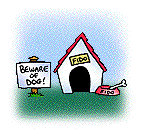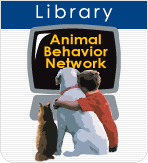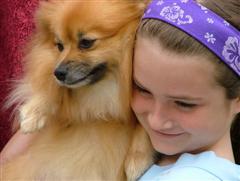|
Need Help?
|
|
Call
1-800-372-3706
to
speak to a Veterinary Behavior Technician |
|
Paws To Speak!
Member
Main Menu
|

Dog Biting
People
Aggression-Toward Family Members
Q&A
Aggression-Diagnosing and
Treating Q&A
Establish that you are a
"friendly, powerful cookie giver". Ask the
dog to sit for a treat. Show the dog the back of
your hand in a low position. If the dog is
gentle, turn your wrist and release the treat.
If the dog's body language goes stiff with the tail
high or very low, back away.
At Home
Teach your dog to come, sit, lie down, etc.,
to earn every meal, walk, toy, and praise.
|
 |
|
Help is at your
fingertips by library, email and
phone. |

Click on
Library Icon
to learn more
|
Introduction
As a dog grows up, we need to teach him or her not
to be aggressive toward family members or any other
individual that is introduced as a friend. From
puppyhood through adulthood, make a point to cue
your dog when someone is friendly by coaxing to your
dog in a cheerful voice,
"Say Hi!"
|
For challenging dogs, it is
wise to requires the dog
"learn to earn" everything
that he or she wants or
needs just to keep the
picture straight in the
dog's mind. |
One way to prevent dog
aggression is make sure the dog trusts all
members of the family. Human members of the family should
not cater to the dog's every
wish, give everything the dog wants, and pet the dog
every time it wants. The dog learns to keep asking
and bugging you until it gets what it wants. Allowing
the dog to assume responsibility to lead and control
all interactions leads to trouble!
There is a simply way to prevent this
misunderstanding and turn of events. On a daily
basis, you can remind the dog of his or her job to
earn any privilege or valued resource by
implementing "learn to
earn".
of the family. Human members of the family should
not cater to the dog's every
wish, give everything the dog wants, and pet the dog
every time it wants. The dog learns to keep asking
and bugging you until it gets what it wants. Allowing
the dog to assume responsibility to lead and control
all interactions leads to trouble!
There is a simply way to prevent this
misunderstanding and turn of events. On a daily
basis, you can remind the dog of his or her job to
earn any privilege or valued resource by
implementing "learn to
earn".
Some dogs, especially those bred
to be challenging guard dogs,
are inclined to take charge and
will quickly take over the
house. When this happens, a
family member may be surprised
by the dog showing aggression
not knowing the dog is enforcing
a "dog established" rule. For
example, you may allow the dog
on the couch. But one day, you
decide enough is enough and push
the dog off the couch. If he
loves this "favored
resting place" a natural response from
the dog may be to growl and push
his way back onto the couch. If
the human does not understand
the dynamic at hand, and in
disgust, pushes the dog off once
again, the dog may bite. In the
dog's mind, the human is acting
out and the dog is simply
controlling the situation within
the established roles and rules
of the household.
Raising an ideal family dog
1. Choose or select a dog
breed with a very low tendency to become aggressive.
Avoid adopting dogs bred to be guard dogs. Adopt a
dog who has been temperament tested.
2. Start as a puppy and
throughout the dog's life, perform frequent
body massages, range of motion, and
positive
restraint exercises
to teach the dog that hands
are good things and maintain a leadership position.
These exercises are most effective when every member
of the family members practices them with the dog.
.jpg)
3. All
family members need to expect the dog to "learn to
earn" attention and other valued resources. Family
members need to ask the dog to follow rules such as
responding to a request to "sit-stay " before
getting something he or she wants.
4. No aggressive play is
allowed with the dog. Aggressive play is any
game that involves slapping or canine nipping or
hard pressure from hands or the dog's mouth. Do not
allow tug-of-war games unless the dog will "sit"
quickly at any time during the game upon your
request, and will release the toy quickly.
5. Teach
bite inhibition
through establishing a pressure sensitive threshold
on human skin. Any time the dog puts more pressure
than that threshold, play is stopped and the dog has
a time out with no social interaction for at least
30 seconds.
6.
Enroll the dog in an obedience class and take the
entire family.
|